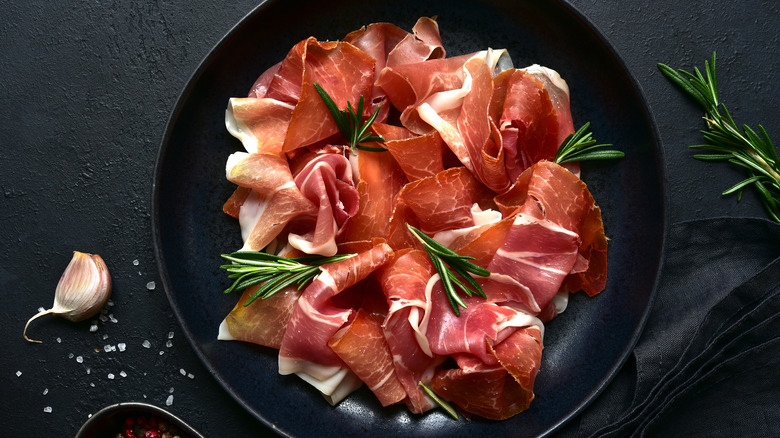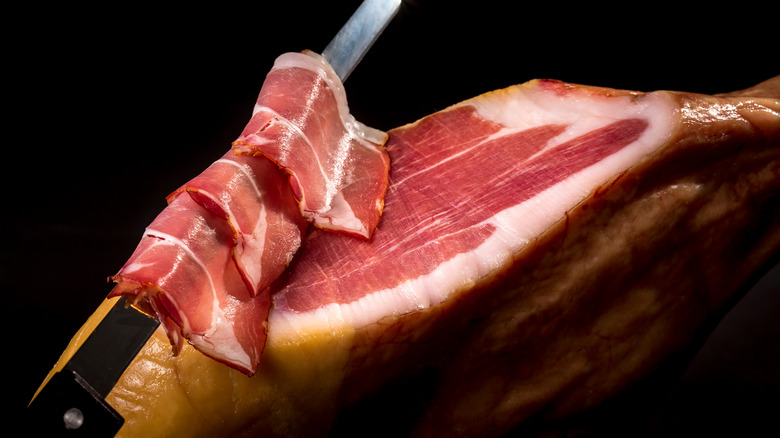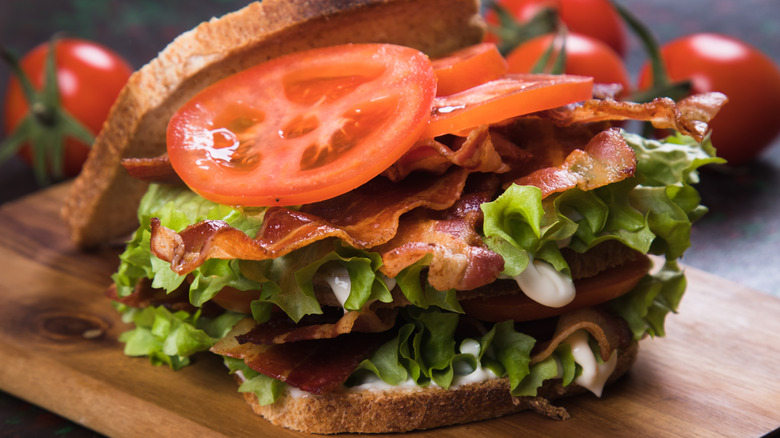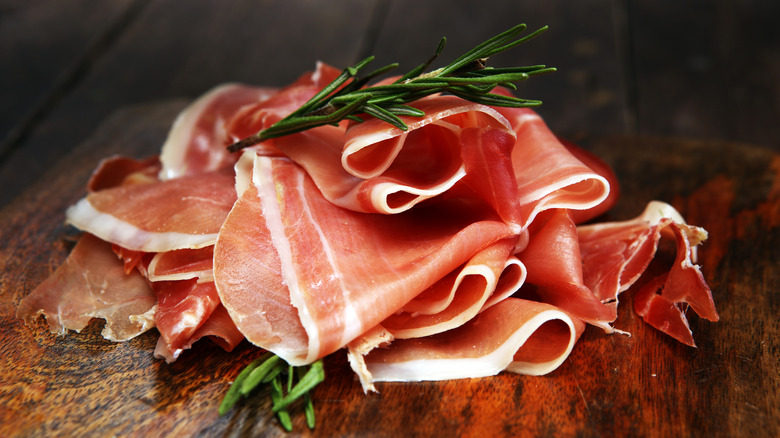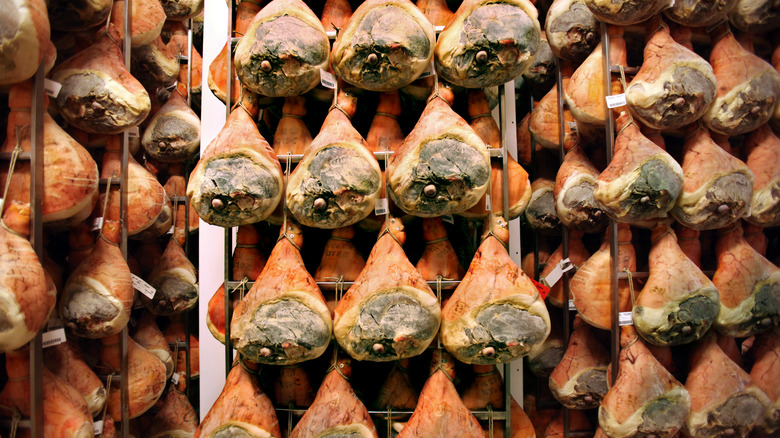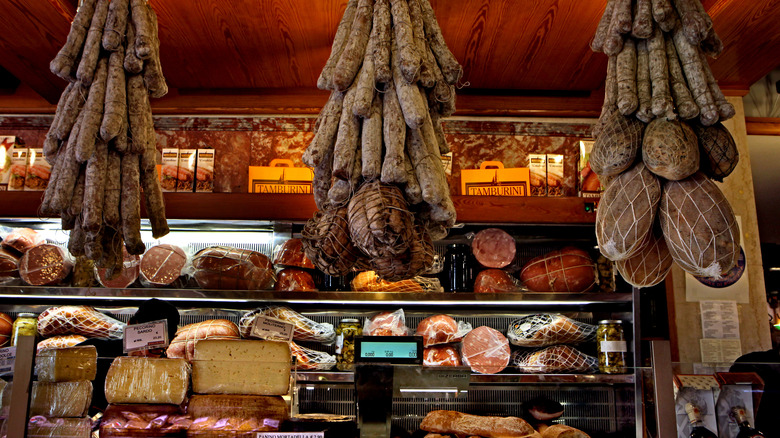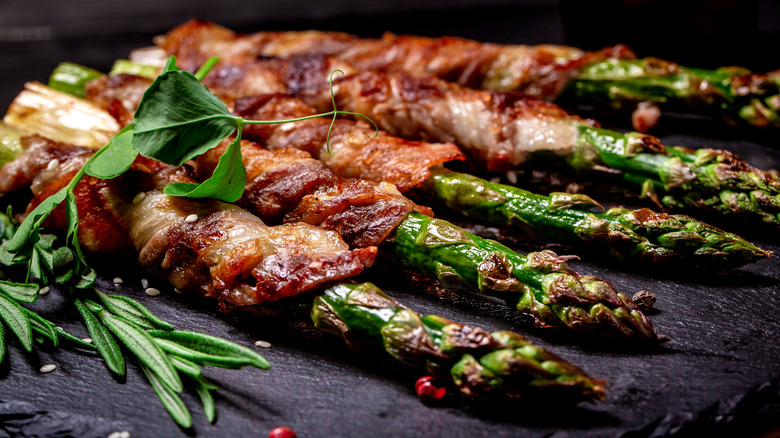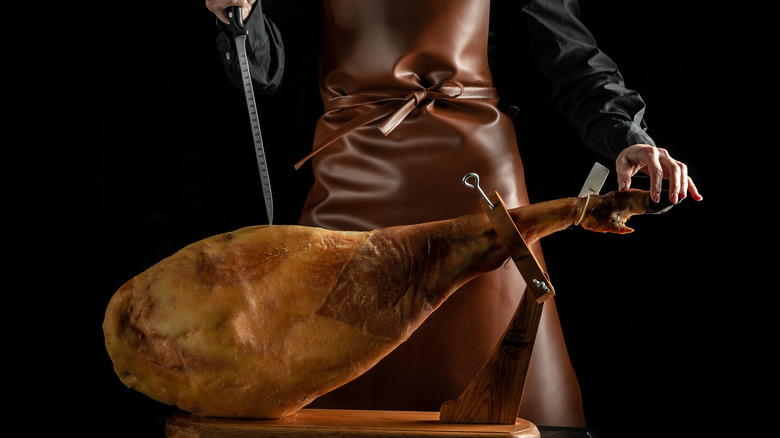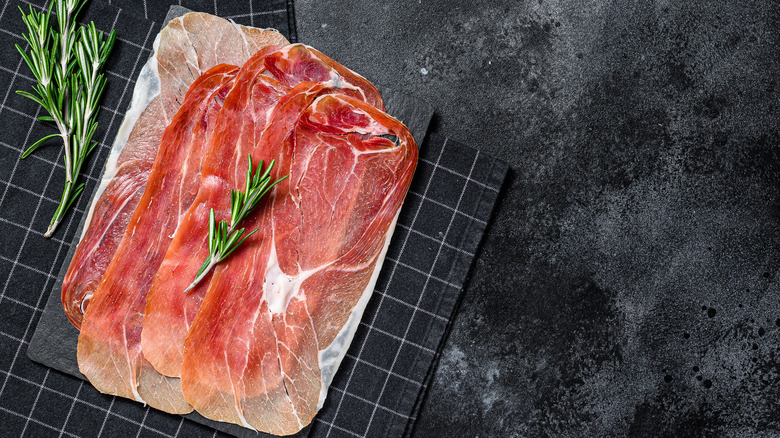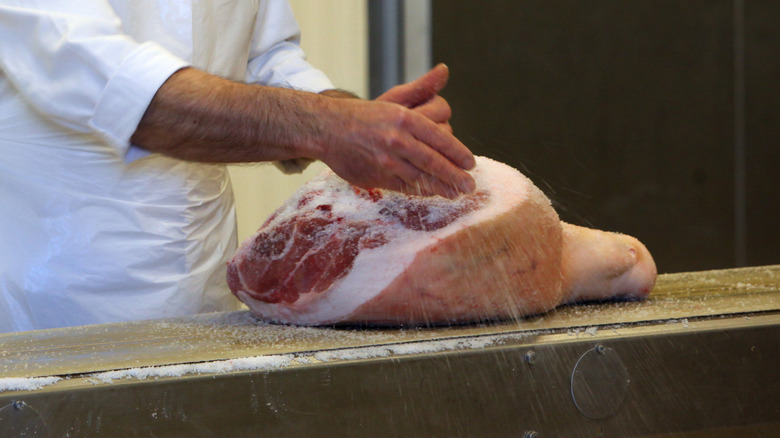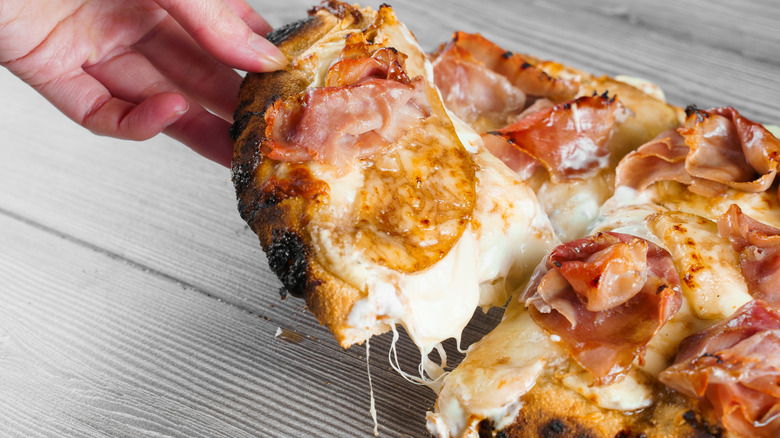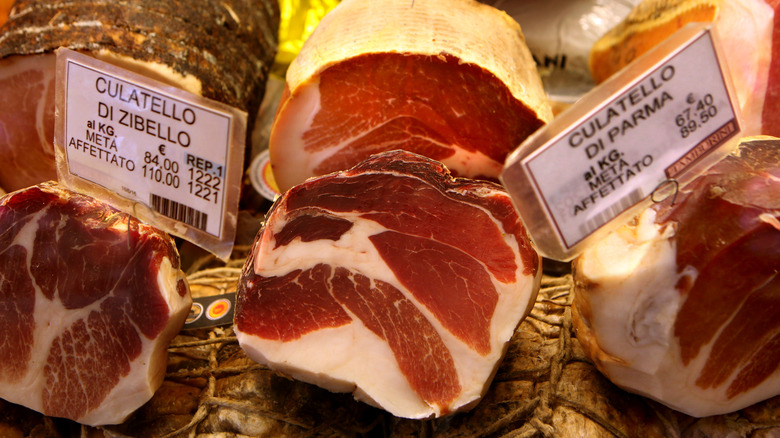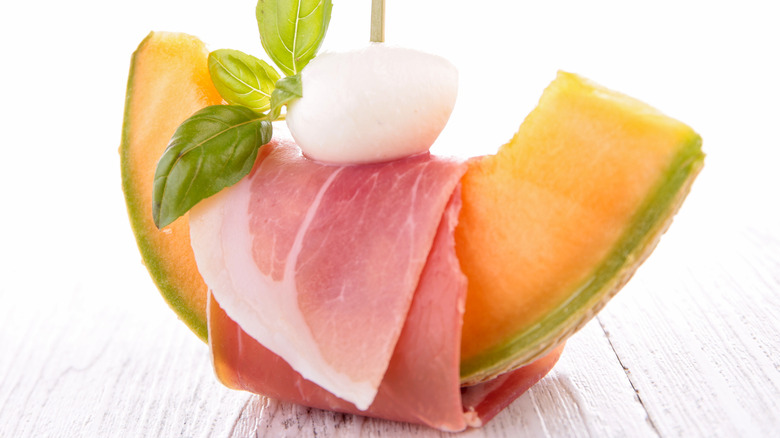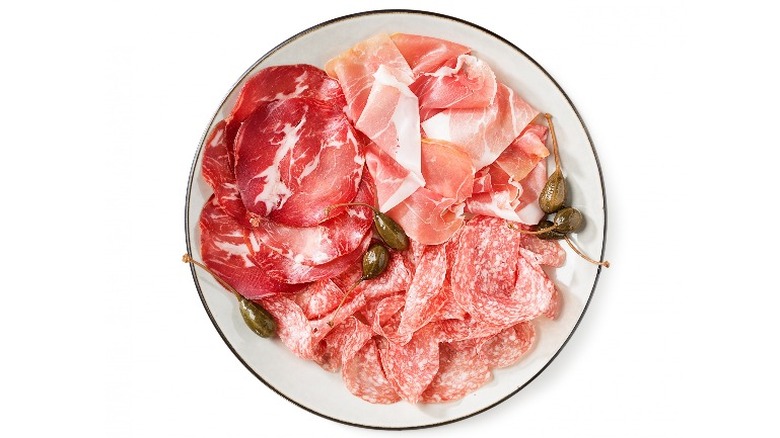The Truth About Prosciutto
Prosciutto may sound unachievably fancy, but it's really just traditional Italian deli meat that can now be widely found in the United States. Specialty imported food shops, as well as grocery stores, cheese shops, and restaurants, are nearly all stocking and serving prosciutto now, but it may still be a new ingredient to some curious foodies. If you're not familiar with this paper-thin slice of heaven, we're here to let you know everything you need to know about it.
Originally from Parma, according to Cook's Illustrated, aged prosciutto is produced all across Italy as well as domestically. There are as many different varieties of prosciutto as there are people making it, with subtle variations that appeal to different appetites, meals, and preparations. There's no one way to enjoy prosciutto, but we whole-heartedly believe that a plate of freshly-sliced prosciutto, served alongside some ripe summer melon, fresh mozzarella, and a few ciabatta rolls, makes for an incredible afternoon snack with friends. Read on to find out how it's made, how it can fit into your diet, and learn about all of the different things you can do with prosciutto.
Prosciutto is high in sodium
When you take a bite of prosciutto, you may notice that it's a little bit on the salty side. This is because salt is absolutely integral to the curing process that makes this type of meat unique. Prosciutto is made by covering the hind leg from a pig in salt, then allowing it to cure in a temperature-controlled environment for a specific amount of time, often for months or even years. According to Bethany Moncel at The Spruce Eats, "The salting process removes leftover moisture, creating [a] nonconducive environment for bacteria to form. It also creates a distinctive flavor."
As you can imagine, a process that requires so much salt will give you a final product that's pretty high in sodium. For example, one ounce (typically 2 slices) of Boar's Head Prosciutto di Parma contains about 660mg of sodium or about 27% of your daily recommended sodium intake. Yikes! Livestrong points out that "regularly eating large doses of sodium can raise your blood pressure, which puts you at an increased risk for heart attack and stroke." For those who already have high blood pressure, the recommended daily dose of sodium is even lower, topping out at 1,500mg per day.
Prosciutto is delicious and indulgent, and we're certainly not here to deprive you of that joy. Armed with the facts, you can easily work it into your diet occasionally. However, you might be overdoing it if you have prosciutto every day.
It's also high in fat
Much like a cut of steak, you'll likely notice the fat marbling in a slice of prosciutto similar to what you might see on large steak cuts and duck breasts. While all of this fat is intentionally left on the prosciutto and is completely edible, it obviously contributes to a higher fat content than other deli-style meats. The actual amount of fat varies widely, depending on the brand and how much fat has been trimmed off of the prosciutto before it's served.
But don't be so quick to trim the fat off the side of your prosciutto. It's there for a reason. Ideally, the fat attached to the meat should be buttery soft at room temperature and serves as a creamy balance to the saltiness of the meat. As Domenica Marchetti for the Chicago Tribune writes, "Prosciutto is about balance: fat to lean, white to red, sweet to salt, buttery to sharp. When you take away that sliver of fat, you're left with nothing but the salty, metallic flavor of the meat."
At this point, you probably understand and accept that prosciutto is not diet food. But that doesn't mean it doesn't have a place in your healthy eating lifestyle. Fat, at least when consumed in moderation, can be your friend. It's also worth experiencing this specialty meat the way it was intended to be eaten before deciding if it's for you or not, fat included.
It might be healthier than bacon
Prosciutto is typically sourced from the hind leg meat of a pig, while bacon comes from pork belly. They're different cuts of pork but can occasionally be interchangeable, depending on the meal. Bacon needs to be cooked before eating to achieve that perfectly crispy bite, while prosciutto doesn't need to be cooked but can also be pan-fried to achieve similar results. Now, we've already established that prosciutto is high in sodium, which remains true when compared with bacon. But according to Zee Krstic at CookingLight, prosciutto may be healthier than bacon in other ways.
In a side-by-side comparison, Krstic notes that bacon has double the amount of calories per serving and double the fat. One serving is generally considered to be two slices of prosciutto or three slices of bacon. We'd like to note that you should enjoy bacon and prosciutto in moderation for the healthiest diet. But depending on what your diet goals are or what you have on hand, reaching for prosciutto for your next BLT might be the better alternative.
To get that satisfyingly crunchy prosciutto, simply lay strips of bacon on a parchment-lined sheet tray and bake at 400°F for about 15 minutes. Depending on how thick the prosciutto is sliced, it may cook quickly, so it's best to check after 10 minutes and keep an eye on it. Once cooled, you can crumble the prosciutto over salads, add it to sandwiches, or enjoy it with your breakfast.
Prosciutto is an aged meat, so it's got robust flavor
You can buy both prosciutto, bacon, and ham pre-sliced, or order it at the deli counter get it sliced to order. But, while they are all pork products, these types of meat are produced differently and cover a wide spectrum of flavor. Typical deli ham as you know it is ham that's been cured. This is a process that involves injecting the pork with a brine, then cooking it at a low temperature to maintain the juiciness and tenderness of the meat while killing off bacteria and making the meat safe to consume (via The Spruce Eats).
Bacon is either cured like ham or sold raw. Raw bacon is usually salted and occasionally spiced or smoked before aging and drying (via The Guardian). This process produces a pork flavor that's more intense than fresh or brine-cured pork. So you can imagine that prosciutto, which is salted and left to age in a temperature-controlled environment for months, if not years, has an even more robust flavor than ham and bacon. After many days of dry-aging, the meat has developed sharper salty and sweet notes, with a touch of yeastiness and a creamy fat cap to balance it all out. The strong flavor of prosciutto may surprise someone who's expecting something more along the lines of bacon.
It's more expensive than bacon and other cured meats
The process of making prosciutto takes much more time than that of average ham or bacon production. With that comes additional costs, which ultimately make prosciutto a more expensive product. But, remember that you can expect that you're only getting the highest quality meat, especially if you're buying authentic prosciutto from Parma, Italy. Not any pork leg will do, and each leg is individually inspected for the perfect thickness and fat coating.
"[Prosciutto] is salted, washed, pre-cured, greased and cellared to get to the point where experts smell it to check the quality. That process takes approximately 780 days for a 12 month-aged ham," writes Sarah Kimmorley for Business Insider. "[Y]our ham could age 2 or 3 years before it gets to the plate." With an aging process so extensive, it becomes clear that time is the most expensive ingredient when it comes to making prosciutto.
There are lower-priced options available that are typically domestic and sometimes aged for a shorter amount of time than classic Italian prosciutto. You can even find pre-sliced prosciutto at many grocery stores, but it's generally considered lower quality than freshly-sliced prosciutto and typically comes at a lower price. When you can, buy the best prosciutto you can afford. And when you get the chance to taste the "authentic" stuff, do it!
Italian prosciutto was difficult to find in the U.S. for a long time
Until 2013, if you enjoyed a good cured Italian meat like prosciutto or soppressata, there's a good chance that it didn't actually come from Italy, or it was smuggled into the country under the noses of customs officials. According to NPR, hundreds of Italian food products were banned from import because of the appearance of swine vesicular disease, a viral infection that can prove costly for veterinarians to treat and prevent (via Merck Manual). The disease was found to be resistant to both curing and cooking. Even mortadella, the bologna-like Italian deli meat studded with pistachios, was banned as a U.S. import until 2000.
Luckily, prosciutto from Parma and San Daniele were two of the only meats cleared for sale in the U.S. during that time. With such a small selection and high import expenses, it was much harder to find back then than it is now. In the last several years, specialty markets and high-end grocery stores have begun offering a wider selection of cured Italian meats. If you find that you like prosciutto, consider giving some other cured meats a taste, too — and appreciate the hard work of vets, inspectors, and importers that have made it safe to eat and easier to find.
There are different types of prosciutto
Prosciutto is a uniquely Italian cured meat, although the practice of making it varies by region and producer and has made its way into other countries with similar results. Prosciutto makers in Parma, Italy claim that their meat is the most authentic prosciutto — a claim hotly contested by prosciutto makers in San Daniele. Both prosciutto styles are recognized worldwide as the highest quality, although they're far from the only producers in Italy. Specialty Italian food purveyor, Eataly says that "The higher altitudes and different climate [of San Daniele prosciutto] give the meat a darker and sweeter flavor." Prosciutto is also produced in Tuscany, Modena, and Carpegna, as well as internationally without the authentic Italian branding.
When it comes to prosciutto, Eataly reports, most people are familiar with the "crudo" version of this delicacy, meaning that the meat in question is raw or uncooked cured prosciutto. There is also a "cotto" version, which is cooked and served more like the hams most Americans are familiar with. In this style, the pork leg is cooked low and slow for a juicy, hammy flavor. This style of prosciutto is typically made with the same heritage breed pigs used for prosciutto crudo, but takes less time to make it onto grocery shelves. It is sliced fresh, usually thinly like its cured brother.
Prosciutto is meant to be eaten raw
It might be hard to imagine that something that's never been cooked, and is in fact has been sitting around for months or years, does not need to be cooked before being eaten. But prosciutto is safe to eat as it is — ideally freshly sliced. This is typical for many cured and aged meats, including salami, capicola, speck, which are similar to prosciutto but with their own unique signatures. That's because, according to "Strategies to Reduce Sodium Intake in the United States", salt acts both as a preservative and an antimicrobial agent, keeping bacteria, fungus, and other nasties from growing in or on salty cured meats.
Now, if you wanted to cook it to enjoy your prosciutto in a crispy format, that's perfectly fine. Many people enjoy the texture and flavor of prosciutto that's been pan-fried or baked in the oven. It can be eaten as-is like delightful meat chips, cooked as a pizza topping, used in a sandwich either raw or cooked, or crumbled on top of vegetables or even fruits for a salty-sweet punch. Before you decide to cook it though, we always recommend taking a taste of it in its original format to really appreciate the prosciutto as it was meant to be eaten.
There's a special way to slice prosciutto
One of the first things you'll notice about a slice of high-quality prosciutto is how thin it is. The paper-thin slices are delicate enough to enjoy without becoming too jerky-like and chewy, with fat that should melt in your mouth. The delicate cuts are easiest to achieve on a meat slicer, which an experienced butcher or deli worker should know how to cut correctly. Some die-hard cured meat fans insist that a hand-cranked meat slicer is the best way to slice prosciutto. Less heat is created from friction during the slicing process since it doesn't have a motor. Less heat means less melting of the fat and potentially produces a cleaner cut overall.
But the process of making prosciutto has been around longer than modern meat slicers, and there is a method for cutting the meat by hand as well (via Food52). This technique involves cutting down the long side of the meat, which may be stabilized in a special carving stand. A long, thin, very sharp non-serrated knife is used to shave off thin sheets of prosciutto. While this method is classic, it takes a lot of practice to achieve the long ribbon-like strips that are so prized by prosciutto fans. Most newbie meat preparators begin with smaller bite-sized bits and work their way up to larger strips of meat. Whether the prosciutto is being sliced on a machine or by hand, the goal is to make the thinnest slices possible.
Prosciutto can go bad if not stored properly
Since prosciutto is aged for so long, you might be wondering if it can go bad. Remember that, while a leg of prosciutto is aging, it's ideally being temperature controlled under strict supervision. Once the prosciutto leaves that controlled environment, the clock starts ticking on how long it remains good, depending in large part on the way it's handled thereafter. If the leg is completely intact, packaged properly, and stored in a cool or refrigerated place, it likely has another 6 to 12 months left, according to Foodsguy. But it's not terribly reasonable to assume that most of us will be storing a whole leg of prosciutto at home, at least not very often. Instead, you're more likely to find prepared slices of the meat in someone's kitchen.
Once prosciutto has been freshly sliced, it should be stored and treated like any other deli meat. It's best to eat it within a few days, and if you notice any off-putting smells or colors, it's time to toss it. Prosciutto that comes pre-sliced and vacuum-sealed has a longer shelf life, which should be listed on the packaging. But once it's been unsealed, it should also be eaten within a few days. Much like sliced ham, prosciutto shows similar signs of spoilage, including discoloration, a funky smell, and a sticky or slimy texture.
It's not cured with nitrates
You may have come across the word "nitrates" when looking up nutritional information about ham. While there's a lot of information out there about nitrates, the BBC quickly breaks down exactly what they are and what they do in our food. "Nitrates and nitrites, such as potassium nitrate and sodium nitrite [...] are legal preservatives which suppress harmful bacteria in bacon, ham, salami and some cheeses." Seems simple enough, but some studies have linked high nitrate consumption to cancers, raising alarms for many.
The nitrate issue is a complex one, with lots of legal guidelines and confusing ramifications for your health. But with prosciutto, you can put all of those fears aside. Prosciutto is cured with only sea salt, the right constant temperature, and a lot of time. It might get a bad rap for being a sodium-packed food, but it should also be celebrated for how unprocessed it is in a world of highly processed mystery meats. It's certainly not the perfect diet food, but if you have concerns about how processed your food is, do a little research on how the meats you love are processed to make the best food choices for you. You might find that prosciutto is a pretty attractive choice.
You can easily use prosciutto in your cooking
Traditionally, prosciutto is served by itself, perhaps with a drizzle of olive oil or balsamic vinegar, and occasionally with fresh cheese or fruit, perhaps as part of a charcuterie board. But the possibilities for serving and enjoying prosciutto are nearly endless. It's phenomenal in a panini with mozzarella or goat cheese and some fresh basil. It's perfect crisped in the oven and crumbled over your favorite pasta or used to really elevate some macaroni and cheese or pizza. Prosciutto in place of bacon for breakfast or baked into quiche is a luxurious swap, too. It's likewise lovely roasted or sauteed with fresh vegetables and squashes. Heck, you can even basically turn it into candy. There's hardly a season or a meal where prosciutto doesn't shine.
As you get started on your prosciutto journey, remember not to take it all too seriously. Taste it all if you can and see which styles and brands you like the best. Seek out the authentic slices from Parma and try the domestic kinds from your local artisan butcher. Ultimately, it's meant to be enjoyed with friends and family, so don't be shy about serving a plate of this sweet and salty treat at your next dinner party or al fresco at your next picnic. Buon Appetito!
What should you look for when buying prosciutto?
If you can find it, imported authentic prosciutto from Parma, Italy, is the best type to buy. Top-quality prosciutto should be sliced to order and ideally laid between pieces of wax or parchment paper. When prosciutto is sliced correctly (that is to say, paper-thin), it melts on the tongue. However, this can also make it stick together. If you go to a quality Italian butcher, they should separate the slices for you. Some lower-quality (and cheaper) types of prosciutto are also available in American supermarkets. Often, these products come pre-sliced and placed between slices of wax paper already.
Wherever you buy your prosciutto, the meat should be a nice pink or red color. Brown prosciutto has been exposed to air and may indicate that it is old or hasn't been properly handled. Make sure there is no trace of mold or spoilage before buying any prosciutto, sliced or otherwise.
For salty and sweet, try Prosciutto e Melone
If reading about all this prosciutto is making you hungry, you might be looking for the best way to eat it. A classic way to eat prosciutto (other than on its own by the slice) is paired with fresh summer melon. In Italy, this dish is called prosciutto e melone. The combination of the sweet, crisp, juicy melon works perfectly with the salty, fatty pork flavor of the cured prosciutto. This simple dish is easy to prepare and serve: just wrap slices of prosciutto around slices of melon.
If you want to take it a step further, you can even pickle watermelon rind to make a delectable, peppery salad featuring prosciutto and melon. For the winter months when melon is no longer in season, you can still enjoy the salty-sweet combination of prosciutto e melone by swapping the melon for a winter fruit, like Giada De Laurentiis does with this pear appetizer.
The difference between prosciutto and pancetta
In the world of cured Italian meat, things can easily start to get a bit confusing. There's prosciutto crudo and cotto, pancetta, and many more. Most common recipes will call for either prosciutto (usually crudo) or pancetta. But what's the difference, and are they interchangeable? The answer is, unfortunately not. Prosciutto is made from the leg of the pig, while pancetta is made from the belly and is more similar to American bacon.
Pancetta is quicker to make and often cheaper, and it often gets sliced thicker and diced for using in pasta and vegetable dishes. The high-quality and imported nature of prosciutto means it would be too expensive to use in place of pancetta. According to Ina Garten, when buying pancetta it's better to buy it in a block and dice it up yourself, in order to control the size and thickness of each chunk.
